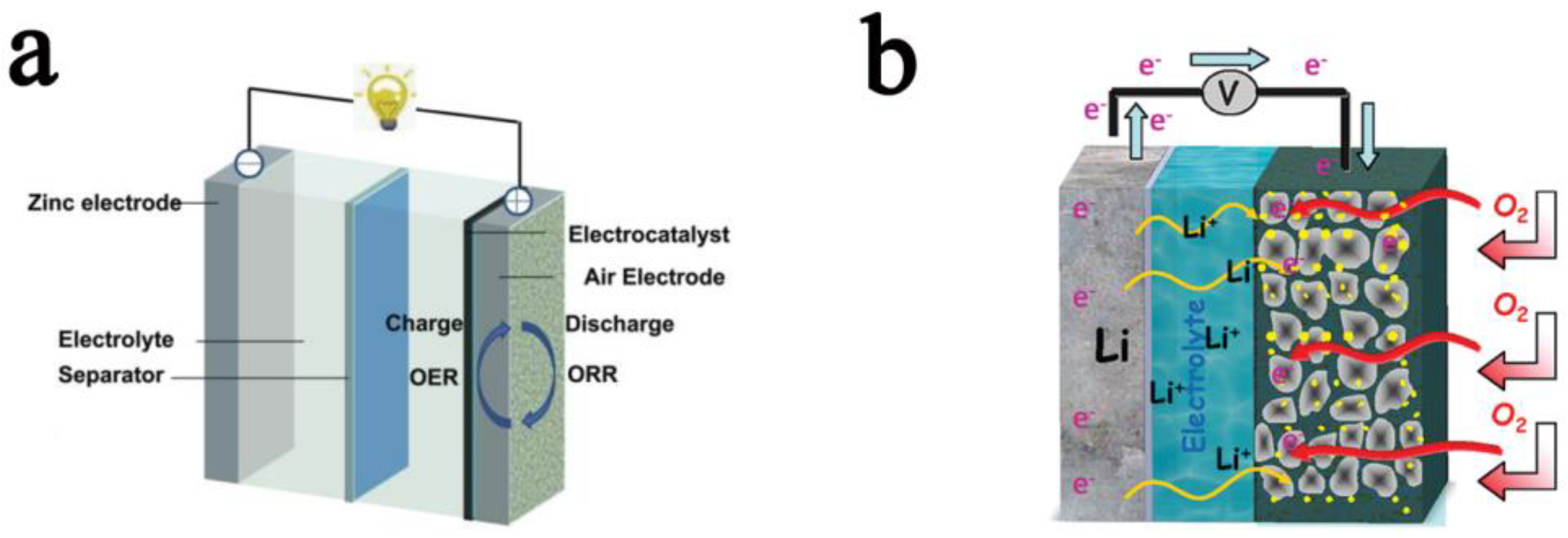Biomass-Derived Carbon Materials for the Electrode of Metal–Air Batteries
Abstract
1. Introduction
2. Raw Materials and Advantage of Biomass Carbon
3. Strategies for Preparing Biochar Materials
3.1. Carbonization with Activation
3.2. Carbonization without Activation
3.3. Hydrothermal Carbonization
3.4. Template Carbonization
4. Biomass Carbon-Based Air Cathode for Metal–air Batteries
4.1. Outline
4.2. Biomass Carbon with Heteroatoms Doping
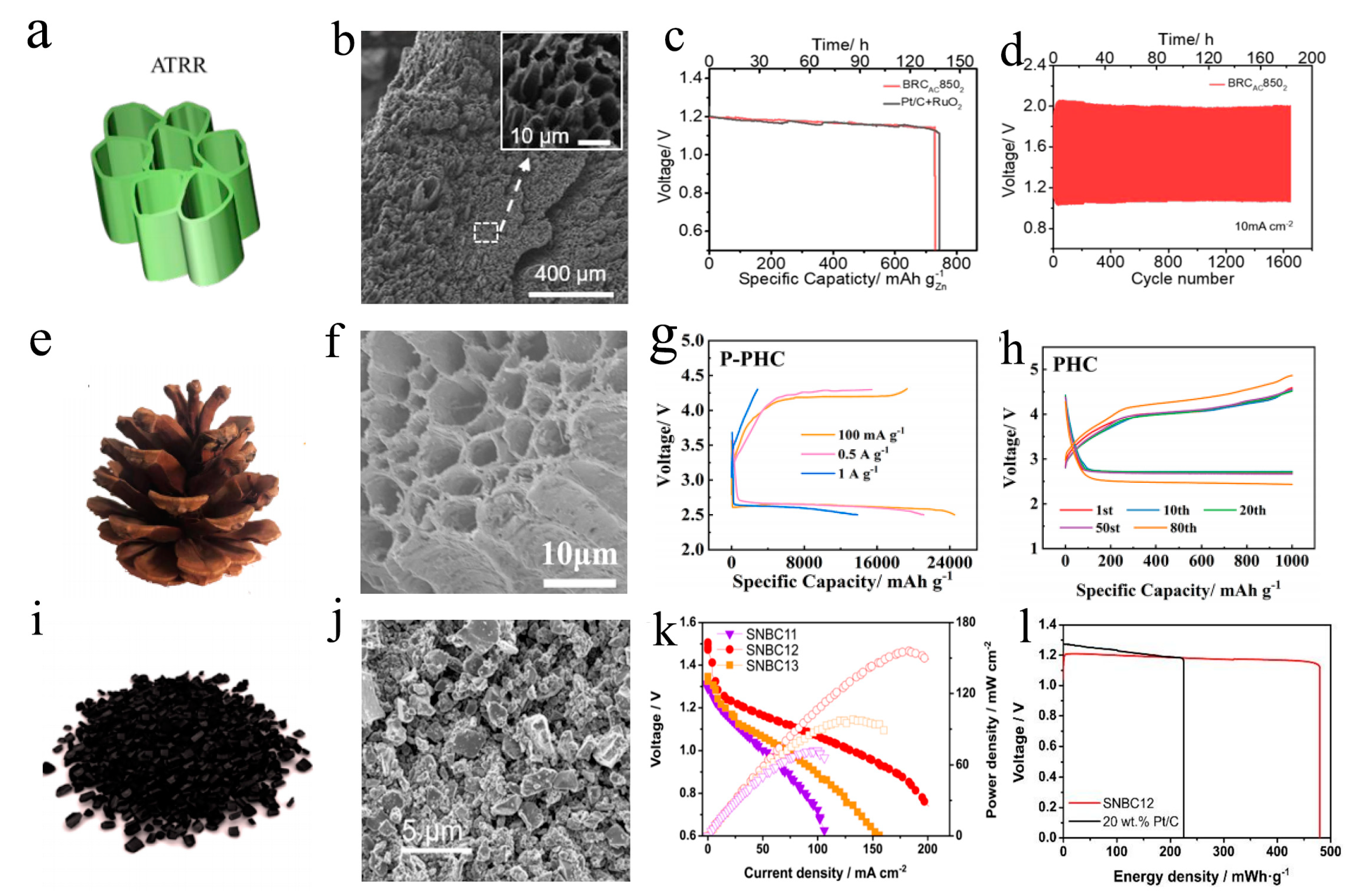
4.3. Biomass Carbon Supported with Catalyst
4.4. Biomass Carbon with Self-Standing Structure
5. Conclusions and Prospects
Author Contributions
Funding
Institutional Review Board Statement
Informed Consent Statement
Data Availability Statement
Conflicts of Interest
References
- Panwar, N.L.; Kaushik, S.C.; Kothari, S. Role of renewable energy sources in environmental protection: A review. Renew. Sustain. Energy Rev. 2011, 15, 1513–1524. [Google Scholar] [CrossRef]
- Angelis-Dimakis, A.; Biberacher, M.; Dominguez, J.; Fiorese, G.; Gadocha, S.; Gnansounou, E.; Guariso, G.; Kartalidis, A.; Panichelli, L.; Pinedo, I.; et al. Methods and tools to evaluate the availability of renewable energy sources. Renew. Sustain. Energy Rev. 2011, 15, 1182–1200. [Google Scholar] [CrossRef]
- Moriarty, P.; Honnery, D. What is the global potential for renewable energy? Renew. Sust. Energ. Rev. 2012, 16, 244–252. [Google Scholar] [CrossRef]
- Harjanne, A.; Korhonen, J.M. Abandoning the concept of renewable energy. Energy Policy 2018, 127, 330–340. [Google Scholar] [CrossRef]
- Chel, A.; Kaushik, G. Renewable energy technologies for sustainable development of energy efficient building. Alex. Eng. J. 2018, 57, 655–669. [Google Scholar] [CrossRef]
- Evans, A.; Strezov, V.; Evans, T.J. Assessment of utility energy storage options for increased renewable energy penetration. Renew. Sustain. Energy Rev. 2012, 16, 4141–4147. [Google Scholar] [CrossRef]
- Amrouche, S.O.; Rekioua, D.; Rekioua, T.; Bacha, S. Overview of energy storage in renewable energy systems. Int. J. Hydrog. Energy. 2016, 41, 20914–20927. [Google Scholar] [CrossRef]
- Felderhoff, M.; Bogdanović, B. High Temperature Metal Hydrides as Heat Storage Materials for Solar and Related Applications. Int. J. Mol. Sci. 2009, 10, 325–344. [Google Scholar] [CrossRef]
- Ahuja, D.; Kalpna, V.; Varshney, P.K. Metal air battery: A sustainable and low cost material for energy storage. J. Physics Conf. Ser. 2021, 1913, 012065. [Google Scholar] [CrossRef]
- Olabi, A.G.; Onumaegbu, C.; Wilberforce, T.; Ramadan, M.; Abdelkareem, M.A.; Al-Alami, A.H. Critical Review of Energy Storage Systems. Energy 2021, 214, 118987. [Google Scholar] [CrossRef]
- Mathis, T.S.; Kurra, N.; Wang, X.; Pinto, D.; Simon, P.; Gogotsi, Y. Energy Storage Data Reporting in Perspective—Guidelines for Interpreting the Performance of Electrochemical Energy Storage Systems. Adv. Energy Mater. 2019, 9, 1902007. [Google Scholar] [CrossRef]
- McCloskey, B.D.; Bethune, D.S.; Shelby, R.M.; Mori, T.; Scheffler, R.; Speidel, A.; Sherwood, M.; Luntz, A.C. Limitations in Rechargeability of Li-O2 Batteries and Possible Origins. J. Phys. Chem. Lett. 2012, 3, 3043–3047. [Google Scholar] [CrossRef] [PubMed]
- Gallant, B.M.; Mitchell, R.R.; Kwabi, D.G.; Zhou, J.; Zuin, L.; Thompson, C.V.; Shao-Horn, Y. Chemical and Morphological Changes of Li-O2 Battery Electrodes upon Cycling. J. Phys. Chem. C 2012, 116, 20800–20805. [Google Scholar] [CrossRef]
- Park, J.-B.; Lee, S.H.; Jung, H.-G.; Aurbach, D.; Sun, Y.-K. Redox Mediators for Li-O2 Batteries: Status and Perspectives. Adv. Mater. 2017, 30, 1704162. [Google Scholar] [CrossRef] [PubMed]
- McCloskey, B.D.; Speidel, A.; Scheffler, R.; Miller, D.C.; Viswanathan, V.; Hummelshoj, J.S.; Norskov, J.K.; Luntz, A.C. Twin Problems of Interfacial Carbonate Formation in Nonaqueous Li-O2 Batteries. J. Phys. Chem. Lett. 2012, 3, 997–1001. [Google Scholar] [CrossRef]
- McCloskey, B.D.; Scheffler, R.; Speidel, A.; Bethune, D.S.; Shelby, R.M.; Luntz, A.C. On the Efficacy of Electrocatalysis in Nonaqueous Li-O2 Batteries. J. Am. Chem. Soc. 2011, 133, 18038–18041. [Google Scholar] [CrossRef]
- Bruce, P.G.; Freunberger, S.A.; Hardwick, L.J.; Tarascon, J.M. Li-O2 and Li-S batteries with high energy storage. Nat. Mater. 2011, 11, 19–29. [Google Scholar] [CrossRef]
- Black, R.; Adams, B.; Nazar, L.F. Non-Aqueous and Hybrid Li-O2 Batteries. Adv. Energy Mater. 2012, 2, 801–815. [Google Scholar] [CrossRef]
- Kang, S.; Mo, Y.; Ong, S.P.; Ceder, G. A Facile Mechanism for Recharging Li2O2 in Li-O2 Batteries. Chem. Mater. 2013, 25, 3328–3336. [Google Scholar] [CrossRef]
- McCloskey, B.D.; Scheffler, R.; Speidel, A.; Girishkumar, G.; Luntz, A.C. On the Mechanism of Nonaqueous Li–O2 Electrochemistry on C and Its Kinetic Overpotentials: Some Implications for Li–Air Batteries. J. Phys. Chem. C 2012, 116, 23897–23905. [Google Scholar] [CrossRef]
- Hardin, W.G.; Slanac, D.A.; Wang, X.; Dai, S.; Johnston, K.P.; Stevenson, K.J. Highly Active, Nonprecious Metal Perovskite Electrocatalysts for Bifunctional Metal-Air Battery Electrodes. J. Phys. Chem. Lett. 2013, 4, 1254–1259. [Google Scholar] [CrossRef]
- Rahman, M.A.; Wang, X.; Wen, C.; Rani, J.V.; Kanakaiah, V.; Dadmal, T.; Rao, M.S.; Bhavanarushi, S. High Energy Density Metal-Air Batteries: A Review. J. Electrochem. Soc. 2013, 160, A1759–A1771. [Google Scholar] [CrossRef]
- Cardoso, C.E.D.; Almeida, J.C.; Lopes, C.B.; Trindade, T.; Vale, C.; Pereira, E. Recovery of Rare Earth Elements by Carbon-Based Nanomaterials—A Review. Nanomaterials 2019, 9, 814. [Google Scholar] [CrossRef] [PubMed]
- Tripathi, N.; Hills, C.D.; Singh, R.S.; Atkinson, C.J. Biomass waste utilisation in low-carbon products: Harnessing a major potential resource. Npj Clim. Atmos. Sci. 2019, 2, 35. [Google Scholar] [CrossRef]
- McCloskey, B.D.; Scheffler, R.; Speidel, A.; Bethune, D.S.; Shelby, R.M.; Luntz, A.C. Facile one-pot synthesis of low cost MnO2 nanosheet/Super P Li composites with high oxygen reduction reaction activity for Zn-air batteries. J. Power Sources 2011, 133, 18038–18041. [Google Scholar] [CrossRef]
- Higgins, D.; Chen, Z.; Lee, D.U.; Chen, Z. Activated and nitrogen-doped exfoliated graphene as air electrodes for metal-air battery applications. J. Mater Chem. A 2013, 1, 2639–2645. [Google Scholar] [CrossRef]
- Prabu, M.; Ramakrishnan, P.; Nara, H.; Momma, T.; Osaka, T.; Shanmugam, S. Zinc–Air Battery: Understanding the Structure and Morphology Changes of Graphene-Supported CoMn2O4 Bifunctional Catalysts Under Practical Rechargeable Conditions. ACS Appl. Mater. Interfaces 2014, 6, 16545–16555. [Google Scholar] [CrossRef]
- Dinesh, M.M.; Saminathan, K.; Selvam, M.; Srither, S.; Rajendran, V.; Kaler, K.V. Water soluble graphene as electrolyte additive in magnesium-air battery system. J. Power Sources 2015, 276, 32–38. [Google Scholar] [CrossRef]
- Jamesh, M.-I.; Moni, P.; Prakash, A.; Harb, M. ORR/OER activity and zinc-air battery performance of various kinds of graphene-based air catalysts. Mater. Sci. Energy Technol. 2021, 4, 1–22. [Google Scholar] [CrossRef]
- Lim, H.-D.; Park, K.-Y.; Song, H.; Jang, E.Y.; Gwon, H.; Kim, J.; Kim, Y.H.; Lima, M.D.; Robles, R.O.; Lepró, X.; et al. Enhanced Power and Rechargeability of a Li−O2 Battery Based on a Hierarchical-Fibril CNT Electrode. Adv. Mater. 2012, 25, 1348–1352. [Google Scholar] [CrossRef]
- Abbasi, M.K.; Khizar, A. Microbial biomass carbon and nitrogen transformations in a loam soil amended with organic–inorganic N sources and their effect on growth and N-uptake in maize. Ecol. Eng. 2012, 39, 123–132. [Google Scholar] [CrossRef]
- Abdullah, M.O.; Tan, I.A.W.; Lim, L.S. Automobile adsorption air-conditioning system using oil palm biomass-based activated carbon: A review. Renew. Sustain. Energy Rev. 2011, 15, 2061–2072. [Google Scholar] [CrossRef]
- Ahmed, M.B.; Johir, A.H.; Zhou, J.L.; Ngo, H.H.; Nghiem, L.D.; Richardson, C.; Moni, M.A.; Bryant, M.R. Activated carbon preparation from biomass feedstock: Clean production and carbon dioxide adsorption. J. Clean. Prod. 2019, 225, 405–413. [Google Scholar] [CrossRef]
- Thangaraj, B.; Solomon, P.R.; Chuangchote, S.; Wongyao, N.; Surareungchai, W. Biomass-derived Carbon Quantum Dots-A Review. Part 2: Application in Batteries. ChemBioEng Rev. 2021, 8, 302–325. [Google Scholar] [CrossRef]
- Denholm, P. Improving the technical, environmental and social performance of wind energy systems using biomass-based energy storage. Renew. Energy 2006, 31, 1355–1370. [Google Scholar] [CrossRef]
- Zhang, H.; Zhang, Y.; Bai, L.; Zhang, Y.; Sun, L. Effect of physiochemical properties in biomass-derived materials caused by different synthesis methods and their electrochemical properties in supercapacitors. J. Mater. Chem. A 2021, 9, 12521–12552. [Google Scholar] [CrossRef]
- Jo, H.-G.; Ahn, H.-J. Accelerating the Oxygen Reduction Reaction and Oxygen Evolution Reaction Activities of N and P Co-Doped Porous Activated Carbon for Li-O2 Batteries. Catalysts 2020, 10, 1316. [Google Scholar] [CrossRef]
- Li, D.; Wang, Q.; Yao, Y.; Wu, F.; Yu, Y.; Zhang, C. New Application of Waste Citrus Maxima Peel-Derived Carbon as an Oxygen Electrode Material for Lithium Oxygen Batteries. ACS Appl. Mater. Interfaces 2018, 10, 32058–32066. [Google Scholar] [CrossRef]
- Liang, H.; Jia, L.; Chen, F. Three-dimensional self-standing Co@NC octahedron/biochar cathode for non-aqueous Li-O2 batteries: Efficient catalysis for reversible formation and decomposition of LiOH. J. Mater. Sci. 2020, 55, 7792–7804. [Google Scholar] [CrossRef]
- Zhu, C.; Du, L.; Luo, J.; Tang, H.; Cui, Z.; Song, H.; Liao, S. Renewable Wood-Derived Cathode for Li-O2 Batteries. J. Mater. Chem. A 2018, 6, 14291–14298. [Google Scholar] [CrossRef]
- Zhang, Y.; Liu, S.; Zheng, X.; Wang, X.; Xu, Y.; Tang, H.; Kang, F.; Yang, Q.-H.; Luo, J. Biomass Organs Control the Porosity of Their Pyrolyzed Carbon. Adv. Funct. Mater. 2017, 27, 1604687. [Google Scholar] [CrossRef]
- Nizamuddin, S.; Baloch, H.A.; Griffin, G.; Mubarak, N.; Bhutto, A.W.; Abro, R.; Mazari, S.A.; Ali, B.S. An overview of effect of process parameters on hydrothermal carbonization of biomass. Renew. Sustain. Energy Rev. 2017, 73, 1289–1299. [Google Scholar] [CrossRef]
- Heidari, M.; Dutta, A.; Acharya, B.; Mahmud, S. A review of the current knowledge and challenges of hydrothermal carbonization for biomass conversion. J. Energy Inst. 2019, 92, 1779–1799. [Google Scholar] [CrossRef]
- Wang, X.-X.; Gan, S.-C.; Zheng, L.-J.; Li, M.-L.; Xu, J.-J. Bioinspired Fabrication of Strong Self-Standing Egg-Sugarcane Cathodes for Rechargeable Lithium–Oxygen Batteries. CCS Chem. 2021, 3, 1764–1774. [Google Scholar] [CrossRef]
- Xie, Y.; Kocaefe, D.; Chen, C.; Kocaefe, Y. Review of Research on Template Methods in Preparation of Nanomaterials. J. Nanomater. 2016, 2016, 1–10. [Google Scholar] [CrossRef]
- Sumboja, A.; Ge, X.; Zheng, G.; Goh, F.T.; Hor, T.A.; Zong, Y.; Liu, Z. Durable rechargeable zinc-air batteries with neutral electrolyte and manganese oxide catalyst. J. Power Sources 2016, 332, 330–336. [Google Scholar] [CrossRef]
- Lee, J.-S.; Tai Kim, S.; Cao, R.; Choi, N.-S.; Liu, M.; Lee, K.T.; Cho, J. Metal-Air Batteries with High Energy Density: Li-Air versus Zn-Air. Adv. Energy Mater. 2011, 1, 34–50. [Google Scholar] [CrossRef]
- Ang, J.M.; Du, Y.; Tay, B.Y.; Zhao, C.; Kong, J.; Stubbs, L.P.; Lu, X. One-Pot Synthesis of Fe(III)-Polydopamine Complex Nanospheres: Morphological Evolution, Mechanism and Application of The Carbonized Hybrid Nanospheres in Catalysis and Zn-Air Battery. Langmuir 2016, 32, 9265–9275. [Google Scholar] [CrossRef] [PubMed]
- Clark, S.; Latz, A.; Horstmann, B. Rational Development of Neutral Aqueous Electrolytes for Zinc-Air Batteries. ChemSusChem 2017, 10, 4735–4747. [Google Scholar] [CrossRef]
- Clark, S.; Mainar, A.R.; Iruin, E.; Colmenares, L.C.; Blázquez, J.A.; Tolchard, J.R.; Jusys, Z.; Horstmann, B. Designing Aqueous Organic Electrolytes for Zinc-Air Batteries: Method, Simulation, and Validation. Adv. Energy Mater. 2020, 10, 1903470. [Google Scholar] [CrossRef]
- Lim, J.; Jung, J.-W.; Kim, N.-Y.; Lee, G.Y.; Lee, H.J.; Lee, Y.; Choi, D.S.; Yoon, K.R.; Kim, Y.-H.; Kim, I.-D.; et al. N2-dopant of graphene with electrochemically switchable bifunctional ORR/OER catalysis for Zn-air battery. Energy Storage Mater. 2020, 32, 517–524. [Google Scholar] [CrossRef]
- Radwan, A.; Jin, H.; Liu, B.; Chen, Z.; Wu, Q.; Zhao, X.; He, D.; Mu, S. 3D-ZIF scaffold derived carbon encapsulated iron nitride as a synergistic catalyst for ORR and zinc-air battery cathodes. Carbon 2020, 171, 368–375. [Google Scholar] [CrossRef]
- Amiinu, I.S.; Liu, X.; Pu, Z.; Li, W.; Li, Q.; Zhang, J.; Tang, H.; Zhang, H.; Mu, S. From 3D ZIF Nanocrystals to Co–Nx/C Nanorod Array Electrocatalysts for ORR, OER, and Zn-Air Batteries. Adv. Funct. Mater. 2018, 28, 1704638. [Google Scholar] [CrossRef]
- Fu, G.; Wang, Y.; Tang, Y.; Zhou, K.; Goodenough, J.B.; Lee, J.-M. Superior Oxygen Electrocatalysis on Nickel Indium Thiospinels for Rechargeable Zn–Air Batteries. ACS Mater. Lett. 2019, 1, 123–131. [Google Scholar] [CrossRef]
- Yilmaz, E.; Yogi, C.; Yamanaka, K.; Ohta, T.; Byon, H.R. Promoting Formation of Noncrystalline Li2O2 in the Li-O2 Battery with RuO2 Nanoparticles. Nano Lett. 2013, 13, 4679–4684. [Google Scholar] [CrossRef] [PubMed]
- Torayev, A.; Rucci, A.; Magusin, P.C.M.M.; Demortière, A.; De Andrade, V.; Grey, C.P.; Merlet, C.; Franco, A.A. Stochasticity of Pores Interconnectivity in Li-O2 Batteries and its Impact on the Variations in Electrochemical Performance. J. Phys. Chem. Lett. 2018, 9, 791–797. [Google Scholar] [CrossRef] [PubMed]
- Mizuno, F.; Takechi, K.; Higashi, S.; Shiga, T.; Shiotsuki, T.; Takazawa, N.; Sakurabayashi, Y.; Okazaki, S.; Nitta, I.; Kodama, T.; et al. Cathode reaction mechanism of non-aqueous Li–O2 batteries with highly oxygen radical stable electrolyte solvent. J. Power Sources 2013, 228, 47–56. [Google Scholar] [CrossRef]
- Shui, J.-L.; Karan, N.K.; Balasubramanian, M.; Li, S.-Y.; Liu, D.-J. Fe/N/C Composite in Li–O2 Battery: Studies of Catalytic Structure and Activity toward Oxygen Evolution Reaction. J. Am. Chem. Soc. 2012, 134, 16654–16661. [Google Scholar] [CrossRef]
- McCloskey, B.D.; Addison, D. A Viewpoint on Heterogeneous Electrocatalysis and Redox Mediation in Nonaqueous Li-O2 Batteries. ACS Catal. 2016, 7, 772–778. [Google Scholar] [CrossRef]
- Pande, V.; Viswanathan, V. Criteria and Considerations for the Selection of Redox Mediatiors in Nonaqueous Li-O2 Batteries. ACS Energy Lett. 2016, 2, 60–63. [Google Scholar] [CrossRef]
- Lindberg, J.; Wickman, B.; Behm, M.; Cornell, A.; Lindbergh, G. The effect of O2 concentration on the reaction mechanism in Li-O2 batteries. J. Electroanal. Chem. 2017, 797, 1–7. [Google Scholar] [CrossRef]
- Luntz, A.C.; Viswanathan, V.; Voss, J.; Varley, J.B.; Nørskov, J.K.; Scheffler, R.; Speidel, A. Tunneling and Polaron Charge Transport through Li2O2 in Li-O2 Batteries. J. Phys. Chem. Lett. 2013, 4, 3494–3499. [Google Scholar] [CrossRef]
- Thotiyl, M.M.O.; Freunberger, S.; Peng, Z.; Chen, Y.; Liu, Z.; Bruce, P.G. A stable cathode for the aprotic Li–O2 battery. Nat. Mater. 2013, 12, 1050–1056. [Google Scholar] [CrossRef] [PubMed]
- Bae, Y.; Ko, D.-H.; Lee, S.; Lim, H.-D.; Kim, Y.-J.; Shim, H.-S.; Park, H.; Ko, Y.; Park, S.K.; Kwon, H.J.; et al. Enhanced Stability of Coated Carbon Electrode for Li-O2 Batteries and Its Limitations. Adv. Energy Mater. 2018, 8, 1702661. [Google Scholar] [CrossRef]
- Seo, M.H.; Park, M.G.; Lee, D.U.; Wang, X.; Ahn, W.; Noh, S.H.; Choi, S.M.; Cano, Z.P.; Han, B.; Chen, Z. Bifunctionally active and durable hierarchically porous transition metal-based hybrid electrocatalyst for rechargeable metal-air batteries. Appl. Catal. B Environ. 2018, 239, 677–687. [Google Scholar] [CrossRef]
- Begum, H.; Ahmed, M.S.; Jung, S. Template-free synthesis of polyacrylonitrile-derived porous carbon nanoballs on graphene forvefficient oxygen reduction in zinc-air batteries. J. Mater Chem. A 2021, 9, 9644–9654. [Google Scholar] [CrossRef]
- Kowalczk, I.; Read, J.; Salomon, M. Li-air batteries: A classic example of limitations owing to solubilities. Pure Appl. Chem. 2007, 79, 851–860. [Google Scholar] [CrossRef]
- Jung, J.-W.; Cho, S.-H.; Nam, J.S.; Kim, I.-D. Current and future cathode materials for non-aqueous Li-air (O2) battery technology–A focused review. Energy Storage Mater. 2019, 24, 512–528. [Google Scholar] [CrossRef]
- Pendashteh, A.; Vilela, S.; Krivtsov, I.; Ávila-Brande, D.; Palma, J.; Horcajada, P.; Marcilla, R. Bimetal zeolitic imidazolate framework (ZIF-9) derived nitrogen-doped porous carbon as efficient oxygen electrocatalysts for rechargeable Zn-air batteries. J. Power Sources 2019, 427, 299–308. [Google Scholar] [CrossRef]
- Yuasa, M.; Imamura, H.; Nishida, M.; Kida, T.; Shimanoe, K. Preparation of nano-LaNiO3 support electrode for rechargeable metal-air batteries. Electrochem. Commun. 2012, 24, 50–52. [Google Scholar] [CrossRef]
- Park, H.W.; Lee, D.U.; Zamani, P.; Seo, M.H.; Nazar, L.F.; Chen, Z. Electrospun porous nanorod perovskite oxide/nitrogen-doped graphene composite as a bi-functional catalyst for metal air batteries. Nano Energy 2014, 10, 192–200. [Google Scholar] [CrossRef]
- Balamurugan, J.; Nguyen, T.T.; Kim, D.H.; Kim, N.H.; Lee, J.H. 3D nickel molybdenum oxyselenide (Ni1-xMoxOSe) nanoarchitectures as advanced multifunctional catalyst for Zn-air batteries and water splitting. Appl. Catal. B Environ. 2021, 286, 119909. [Google Scholar] [CrossRef]
- Kim, J.; Gwon, O.; Mahmood, J.; Kim, C.; Yang, Y.; Lee, H.; Lee, J.H.; Jeong, H.Y.; Baek, J.-B.; Kim, G. Synergistic Coupling Derived Cobalt Oxide with Nitrogenated Holey Two-Dimensional Matrix as an Efficient Bifunctional Catalyst for Metal–Air Batteries. ACS Nano 2019, 13, 5502–5512. [Google Scholar] [CrossRef] [PubMed]
- Eom, S.-W.; Lee, C.-W.; Yun, M.-S.; Sun, Y.-K. The roles and electrochemical characterizations of activated carbon in zinc air battery cathodes. Electrochim. Acta 2006, 52, 1592–1595. [Google Scholar] [CrossRef]
- Kraytsberg, A.; Ein-Eli, Y. The impact of nano-scaled materials on advanced metal–air battery systems. Nano Energy 2013, 2, 468–480. [Google Scholar] [CrossRef]
- Nandan, R.; Gautam, A.; Nanda, K.K. J Mater Chem A. Mimicking anthocephalus cadamba shaped FeNi encapsulated carbon nanostructures for metal-air batteries as resilient bifunctional oxygen electrocatalyst. Electrochim. Acta 2018, 6, 20411–20420. [Google Scholar] [CrossRef]
- Haller, S.; Gridin, V.; Hofmann, K.; Stark, R.W.; Albert, B.; Kramm, U.I. Application of Non-Precious Bifunctional Catalysts for Metal-Air Batteries. Energy Technol. 2021, 9, 2001106. [Google Scholar] [CrossRef]
- Yu, X.; Zhou, T.; Ge, J.; Wu, C. Recent Advances on the Modulation of Electrocatalysts Based on Transition Metal Nitrides for the Rechargeable Zn-Air Battery. ACS Mater. Lett. 2020, 2, 1423–1434. [Google Scholar] [CrossRef]
- Girishkumar, G.; McCloskey, B.; Luntz, A.C.; Swanson, S.; Wilcke, W. Lithium−Air Battery: Promise and Challenges. J. Phys. Chem. Lett. 2010, 1, 2193–2203. [Google Scholar] [CrossRef]
- Feng, X.; Bai, Y.; Liu, M.; Li, Y.; Yang, H.; Wang, X.; Wu, C. Untangling the respective effects of heteroatom-doped carbon materials in batteries, supercapacitors and the ORR to design high performance materials. Energy Environ. Sci. 2021, 14, 2036–2089. [Google Scholar] [CrossRef]
- Ma, Z.; Wang, K.; Qiu, Y.; Liu, X.; Cao, C.; Feng, Y.; Hu, P. Nitrogen and sulfur co-doped porous carbon derived from bio-waste as a promising electrocatalyst for zinc-air battery. Energy 2018, 143, 43–55. [Google Scholar] [CrossRef]
- Kim, M.-J.; Park, J.E.; Kim, S.; Lim, M.S.; Jin, A.; Kim, O.-H.; Kim, M.J.; Lee, K.-S.; Kim, J.; Kim, S.-S.; et al. Biomass-Derived Air Cathode Materials: Pore-Controlled S,N-Co-doped Carbon for Fuel Cells and Metal–Air Batteries. ACS Catal. 2019, 9, 3389–3398. [Google Scholar] [CrossRef]
- Liu, Q.; Liu, X.; Xie, Y.; Sun, F.; Liang, Z.; Wang, L.; Fu, H. N-doped carbon coating enhance bifunctional oxygen reaction activity of CoFe nanoparticles for high stable Zn-air battery. J. Mater Chem. A 2020, 8, 21189–21198. [Google Scholar] [CrossRef]
- Lu, T.; Hu, X.; He, J.; Li, R.; Gao, J.; Lv, Q.; Yang, Z.; Cui, S.; Huang, C. Aqueous/solid state Zn-air batteries based on N doped graphdiyne as efficient metal-free bifunctional catalyst. Nano Energy 2021, 85, 106024. [Google Scholar] [CrossRef]
- Ilnicka, A.; Skorupska, M.; Romanowski, P.; Kamedulski, P.; Lukaszewicz, J.P. Improving the Performance of Zn-Air Batteries with N-Doped Electroexfoliated Graphene. Materials 2020, 13, 2115. [Google Scholar] [CrossRef]
- Singh, S.K.; Takeyasu, K.; Nakamura, J. Active Sites and Mechanism of Oxygen Reduction Reaction Electrocatalysis on Nitrogen-Doped Carbon Materials. Adv. Mater. 2018, 31, e1804297. [Google Scholar] [CrossRef]
- Liu, Y.; Sun, K.; Cui, X.; Li, B.; Jiang, J. Defect-Rich, Graphenelike Carbon Sheets Derived from Biomass as Efficient Electrocatalysts for Rechargeable Zinc–Air Batteries. ACS Sustain. Chem. Eng. 2020, 8, 2981–2989. [Google Scholar] [CrossRef]
- Zeng, H.; Liu, X.; Chen, F.; Chen, Z.; Fan, X.; Lau, W. Single Atoms on a Nitrogen-Doped Boron Phosphide Monolayer: A New Promising Bifunctional Electrocatalyst for ORR and OER. ACS Appl. Mater. Interfaces 2020, 12, 52549–52559. [Google Scholar] [CrossRef]
- Zhao, C.; Liu, G.; Sun, N.; Zhang, X.; Wang, G.; Zhang, Y.; Zhang, H.; Zhao, H. Biomass-derived N-doped porous carbon as electrode materials for Zn-air battery powered capacitive deionization. Chem. Eng. J. 2018, 334, 1270–1280. [Google Scholar] [CrossRef]
- Li, Q.; He, T.; Zhang, Y.-Q.; Wu, H.; Liu, J.; Qi, Y.; Lei, Y.; Chen, H.; Sun, Z.; Peng, C.; et al. Biomass Waste-Derived 3D Metal-Free Porous Carbon as a Bifunctional Electrocatalyst for Rechargeable Zinc–Air Batteries. ACS Sustain. Chem. Eng. 2019, 7, 17039–17046. [Google Scholar] [CrossRef]
- Hoang, V.C.; Gomes, V.G.; Dinh, K.N. Ni- and P-doped carbon from waste biomass: A sustainable multifunctional electrode for oxygen reduction, oxygen evolution and hydrogen evolution reactions. Electrochim. Acta 2019, 314, 49–60. [Google Scholar] [CrossRef]
- Jiang, Z.-L.; Sun, H.; Shi, W.-K.; Cheng, J.-Y.; Hu, J.-Y.; Guo, H.-L.; Gao, M.-Y.; Zhou, H.; Sun, S.-G. P-Doped Hive-like Carbon Derived from Pinecone Biomass as Efficient Catalyst for Li-O2 Battery. ACS Sustain. Chem. Eng. 2019, 7, 14161–14169. [Google Scholar] [CrossRef]
- Zhang, G.; Liu, X.; Wang, L.; Sun, F.; Yang, Y.; Tian, C.; Yu, P.; Pan, Q.; Fu, H. B,N-Doped Defective Carbon Entangled Fe3C Nanoparticles as the Superior Oxygen Reduction Electrocatalyst for Zn–Air Batteries. ACS Sustain. Chem. Eng. 2019, 7, 19104–19112. [Google Scholar] [CrossRef]
- Zhou, Y.; Wu, J.; Wang, Z.; Huang, H.; Liu, Y.; Kang, Z. A biomass derived porous carbon materials with adjustable interfacial electron transmission dynamics as highly-efficient air cathode for Zn-Air battery. Mater. Res. Bull. 2022, 153, 111908. [Google Scholar] [CrossRef]
- Luo, X.; Liu, Z.; Ma, Y.; Nan, Y.; Gu, Y.; Li, S.; Zhou, Q.; Mo, J. Biomass derived Fe,N-doped carbon material as bifunctional electrocatalysts for rechargeable Zn-air batteries. J. Alloy. Compd. 2021, 888, 161464. [Google Scholar] [CrossRef]
- Wang, C.; Xie, N.-H.; Zhang, Y.; Huang, Z.; Xia, K.; Wang, H.; Guo, S.; Xu, B.-Q.; Zhang, Y. Silk-Derived Highly Active Oxygen Electrocatalysts for Flexible and Rechargeable Zn–Air Batteries. Chem. Mater. 2019, 31, 1023–1029. [Google Scholar] [CrossRef]
- Zhang, L.-Y.; Wang, M.-R.; Lai, Y.-Q.; Li, X.-Y. Nitrogen-doped microporous carbon: An efficient oxygen reduction catalyst for Zn-air batteries. J. Power Sources 2017, 359, 71–79. [Google Scholar] [CrossRef]
- Liu, X.; Zhou, Y.; Zhou, W.; Li, L.; Huang, S.; Chen, S. Biomass-derived nitrogen self-doped porous carbon as effective metal-free catalysts for oxygen reduction reaction. Nanoscale 2015, 7, 6136–6142. [Google Scholar] [CrossRef]
- Guo, C.; Liao, W.; Li, Z.; Chen, C. Exploration of the catalytically active site structures of animal biomass-modified on cheap carbon nanospheres for oxygen reduction reaction with high activity, stability and methanol-tolerant performance in alkaline medium. Carbon 2015, 85, 279–288. [Google Scholar] [CrossRef]
- Yao, Y.; Wu, F. Turning Waste Chemicals into Wealth-A New Approach To Synthesize Efficient Cathode Material for an Li-O2 Battery. ACS Appl. Mater. Interfaces 2017, 9, 31907–31912. [Google Scholar] [CrossRef]
- Xu, L.; Tian, Y.; Deng, D.; Li, H.; Zhang, D.; Qian, J.; Wang, S.; Zhang, J.; Li, H.; Sun, S. Cu Nanoclusters/FeN4 Amorphous Composites with Dual Active Sites in N-Doped Graphene for High-Performance Zn–Air Batteries. ACS Appl. Mater. Interfaces 2020, 12, 31340–31350. [Google Scholar] [CrossRef] [PubMed]
- Tan, J.; Thomas, T.; Liu, J.; Yang, L.; Pan, L.; Cao, R.; Shen, H.; Wang, J.; Liu, J.; Yang, M. Rapid microwave-assisted preparation of high-performance bifunctional Ni3Fe/Co-N-C for rechargeable Zn-air battery. Chem. Eng. J. 2020, 395, 125151. [Google Scholar] [CrossRef]
- Wu, Y.-G.; Wen, M.; Wu, Q.-S.; Fang, H. Ni/graphene Nanostructure and Its Electron-Enhanced Catalytic Action for Hydrogenation Reaction of Nitrophenol. J. Phys. Chem. C 2014, 118, 6307–6313. [Google Scholar] [CrossRef]
- Liu, S.; Wan, R.; Lin, Z.; Liu, Z.; Liu, Y.; Tian, Y.; Qin, D.-D.; Tang, Z. Probing the Co role in promoting the OER and Zn-air battery performance of NiFe-LDH: A combined experimental and theoretical study. J. Mater. Chem. A 2022, 10, 5244–5254. [Google Scholar] [CrossRef]
- Wang, Y.; Yu, B.; Liu, K.; Yang, X.; Liu, M.; Chan, T.-S.; Qiu, X.; Li, J.; Li, W. Co single-atoms on ultrathin N-doped porous carbon by biomass complexation strategy for high performance metal-air batteries. J. Mater. Chem. A 2020, 8, 2131–2139. [Google Scholar] [CrossRef]
- Jiang, W.-J.; Gu, L.; Li, L.; Zhang, Y.; Zhang, X.; Zhang, L.-J.; Wang, J.-Q.; Hu, J.-S.; Wei, Z.; Wan, L.-J. Understanding the High Activity of Fe-N-C Electrocatalysts in Oxygen Reduction: Fe/Fe3C Nanoparticles Boost the Activity of Fe–Nx. J. Am. Chem. Soc. 2016, 138, 3570–3578. [Google Scholar] [CrossRef]
- Rong, Z.; Dong, C.; Zhang, S.; Dong, W.; Huang, F. Co5.47N loaded N-doped carbon as an efficient bifunctional oxygen electrocatalyst for Zn-air battery. Nanoscale 2020, 12, 6089–6095. [Google Scholar] [CrossRef]
- Wan, W.; Wang, Q.; Zhang, L.; Liang, H.-W.; Chen, P.; Yu, S.-H. N-, P- and Fe-tridoped nanoporous carbon derived from plant biomass: An excellent oxygen reduction electrocatalyst for zinc–air batteries. J. Mater. Chem. A 2016, 4, 8602–8609. [Google Scholar] [CrossRef]
- Su, D.; Wang, X.; Liu, Y.; Xu, S.; Fang, S.; Cao, S.; Xiao, Y. Co-embedded nitrogen-enriching biomass-derived porous carbon for highly efficient oxygen reduction and flexible zinc-air battery. J. Alloy. Compd. 2022, 896, 162604. [Google Scholar] [CrossRef]
- Xu, L.; Deng, D.; Tian, Y.; Li, H.; Qian, J.; Wu, J.; Li, H. Dual-active-sites design of CoNx anchored on zinc-coordinated nitrogen-codoped porous carbon with efficient oxygen catalysis for high-stable rechargeable zinc-air batteries. Chem. Eng. J. 2021, 408, 127321. [Google Scholar] [CrossRef]
- Tian, Y.; Xu, L.; Bao, J.; Qian, J.; Su, H.; Li, H.; Gu, H.; Yan, C.; Li, H. Hollow cobalt oxide nanoparticles embedded in nitrogen-doped carbon nanosheets as an efficient bifunctional catalyst for Zn–air battery. J. Energy Chem. 2019, 33, 59–66. [Google Scholar] [CrossRef]
- Tian, G.-L.; Zhang, Q.; Zhang, B.; Jin, Y.-G.; Huang, J.-Q.; Su, D.S.; Wei, F. Toward Full Exposure of “Active Sites”: Nanocarbon Electrocatalyst with Surface Enriched Nitrogen for Superior Oxygen Reduction and Evolution Reactivity. Adv. Funct. Mater. 2014, 24, 5956–5961. [Google Scholar] [CrossRef]
- Wang, G.; Deng, Y.; Yu, J.; Zheng, L.; Du, L.; Song, H.; Liao, S. From Chlorella to Nestlike Framework Constructed with Doped Carbon Nanotubes: A Biomass-Derived, High-Performance, Bifunctional Oxygen Reduction/Evolution Catalyst. ACS Appl. Mater. Interfaces 2017, 9, 32168–32178. [Google Scholar] [CrossRef] [PubMed]
- Yoon, K.R.; Lee, G.Y.; Jung, J.W.; Kim, N.H.; Kim, S.O.; Kim, I.D. One-Dimensional RuO2/Mn2O3 Hollow Architectures as Efficient Bifunctional Catalysts for Lithium-Oxygen Batteries. Nano Lett. 2016, 16, 2076–2083. [Google Scholar] [CrossRef] [PubMed]
- Zhu, L.; Scheiba, F.; Trouillet, V.; Georgian, M.; Fu, Q.; Sarapulpva, A.; Sigel, F.; Hua, W.; Ehrenberg, H. MnO2 and Reduced Graphene Oxide as Bifunctional Electro-catalysts for Li-O2 Batteries. ACS Appl. Energy Mater. 2019, 2, 7121–7131. [Google Scholar] [CrossRef]
- Kalubarme, R.S.; Cho, M.S.; Yun, K.S.; Kim, T.S.; Park, C.J. Catalytic characteristics of MnO2 nanostructures for the O2 reduction process. Nanotechnology 2011, 22, 395402. [Google Scholar] [CrossRef]
- Zhao, C.; Yu, C.; Banis, M.N.; Sun, Q.; Zhang, M.; Li, X.; Liu, Y.; Zhao, Y.; Huang, H.; Li, S.; et al. Decoupling atomic-layer-deposition ultrafine RuO2 for high-efficiency and ultralong-life Li-O2 batteries. Nano Energy 2017, 34, 399–407. [Google Scholar] [CrossRef]
- Papp, J.K.; Forster, J.D.; Burke, C.M.; Kim, H.W.; Luntz, A.C.; Shelby, R.M.; Urban, J.J.; McCloskey, B.D. Poly(vinylidene fluoride) (PVDF) Binder Degradation in Li–O2 Batteries: A Consideration for the Characterization of Lithium Superoxide. J. Phys. Chem. Lett. 2017, 8, 1169–1174. [Google Scholar] [CrossRef]
- Yoon, D.H.; Yoon, S.H.; Ryu, K.S.; Park, Y.J. PEDOT: PSS as multi-functional composite material for enhanced Li-air-battery air electrodes. Sci. Rep. 2016, 6, 19962. [Google Scholar] [CrossRef]
- An, S.J.; Li, J.; Daniel, C.; Wood, D.L. Effects of Ultraviolet Light Treatment in Ambient Air on Lithium-Ion Battery Graphite and PVDF Binder. J. Electrochem. Soc. 2019, 166, A1121. [Google Scholar] [CrossRef]
- Jing, S.; Zhang, M.; Liang, H.; Shen, B.; Yin, S.; Yang, X. Facile synthesis of 3D binder-free N-doped carbon nanonet derived from silkworm cocoon for Li–O2 battery. J. Mater. Sci. 2017, 53, 4395–4405. [Google Scholar] [CrossRef]
- Wang, Y.; Jin, M.; Zhang, X.; Zhao, C.; Wang, H.; Li, S.; Liu, Z. Direct Conversion of Biomass into Compact Air Electrode with Atomically Dispersed Oxygen and Nitrogen Coordinated Copper Species for Flexible Zinc–Air Batteries. ACS Appl. Energy Mater. 2019, 2, 8659–8666. [Google Scholar] [CrossRef]
- Wang, Y.; Zhu, X.; Yan, Y.; Wan, W.; Wu, Y.; Ji, X.; Lü, Z. CNTs-grafted cotton fabrics as binder-free, free-standing and cost-efficient cathodes for flexible Li-O2 batteries. Mater. Lett. 2018, 233, 8–11. [Google Scholar] [CrossRef]
- Jing, S.; Gai, Z.; Li, M.; Tang, S.; Ji, S.; Liang, H.; Chen, F.; Yin, S.; Tsiakaras, P. Enhanced electrochemical performance of a Li-O2 battery using Co and N co-doped biochar cathode prepared in molten salt medium. Electrochim. Acta 2022, 410, 140002. [Google Scholar] [CrossRef]
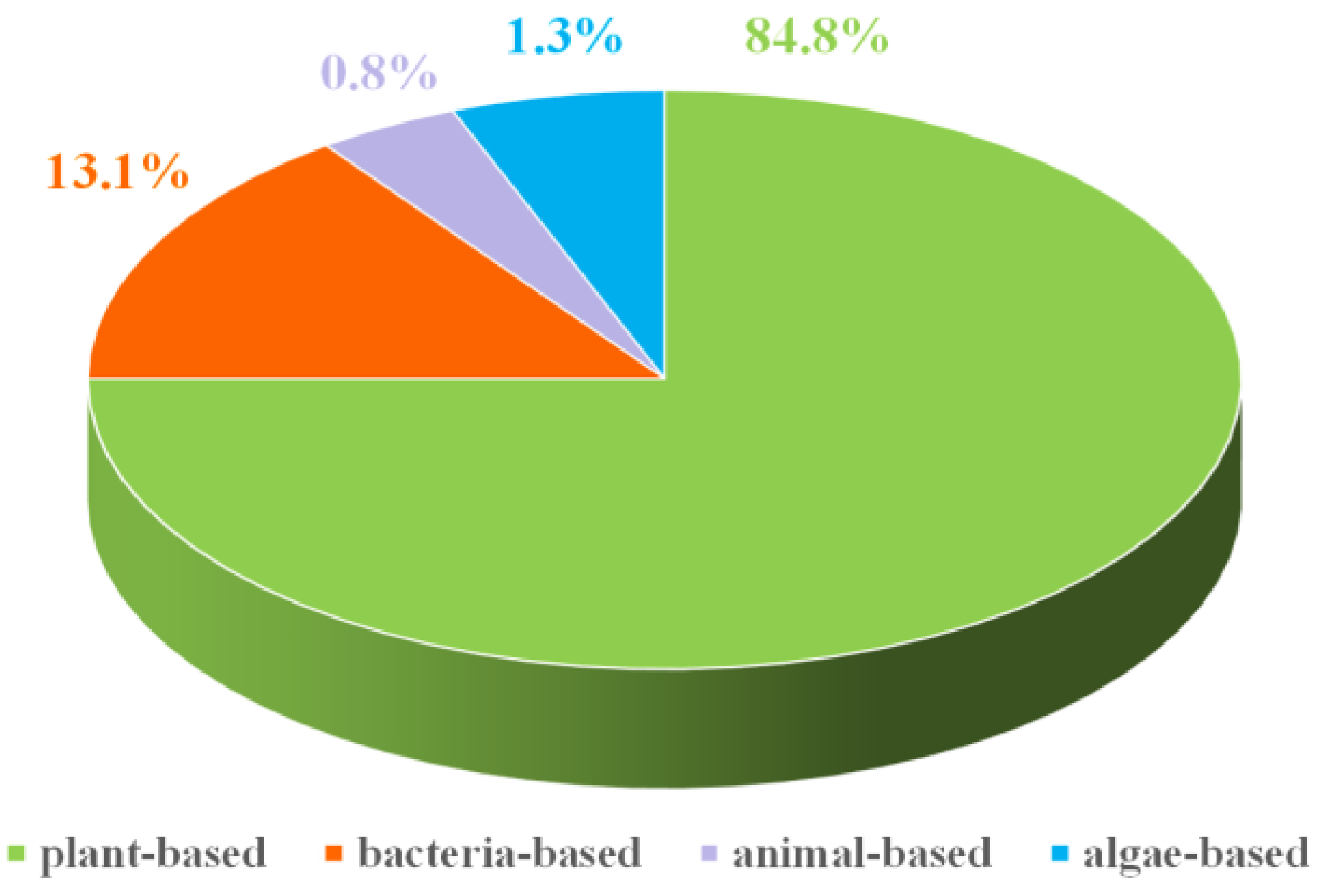
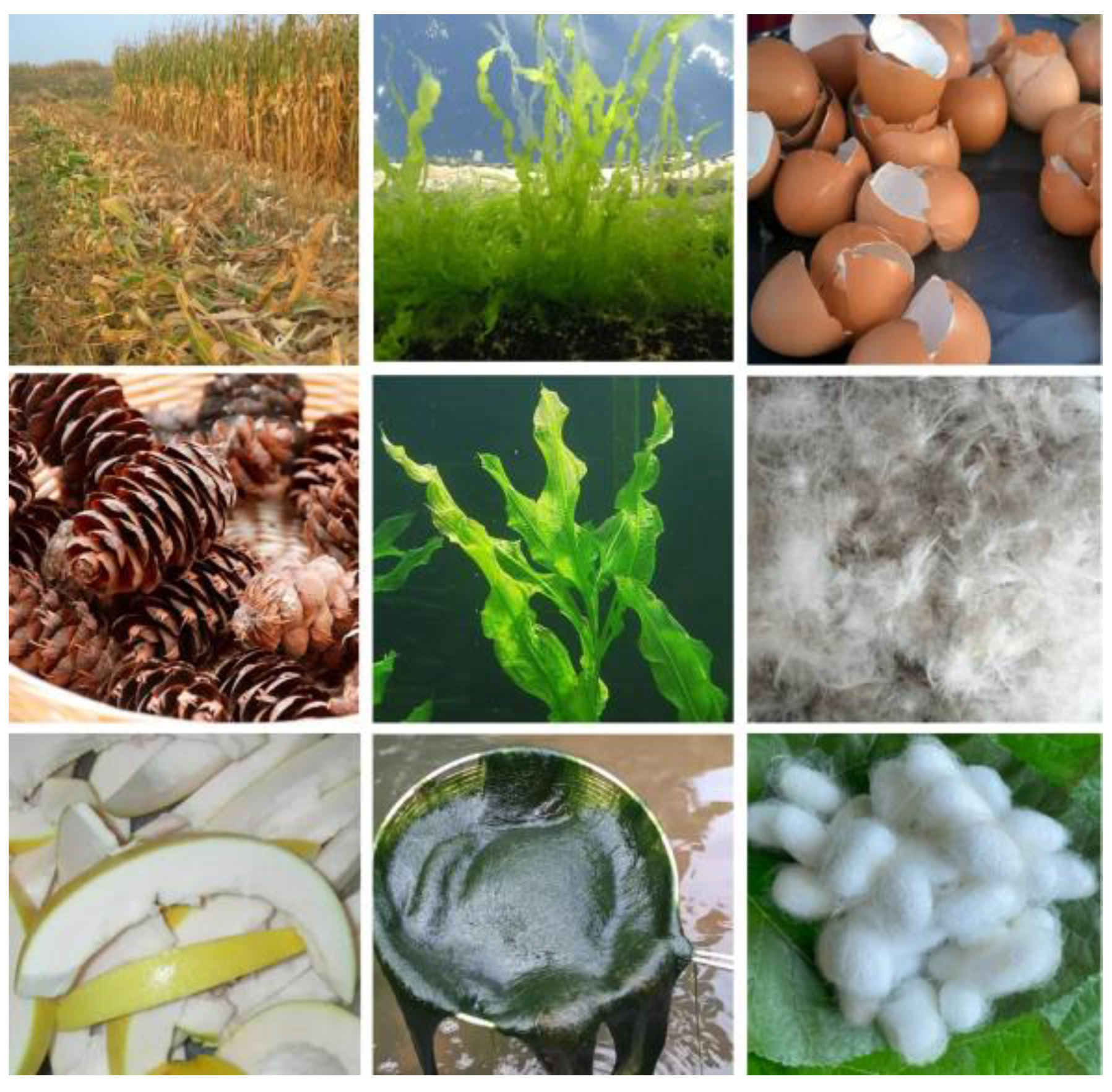
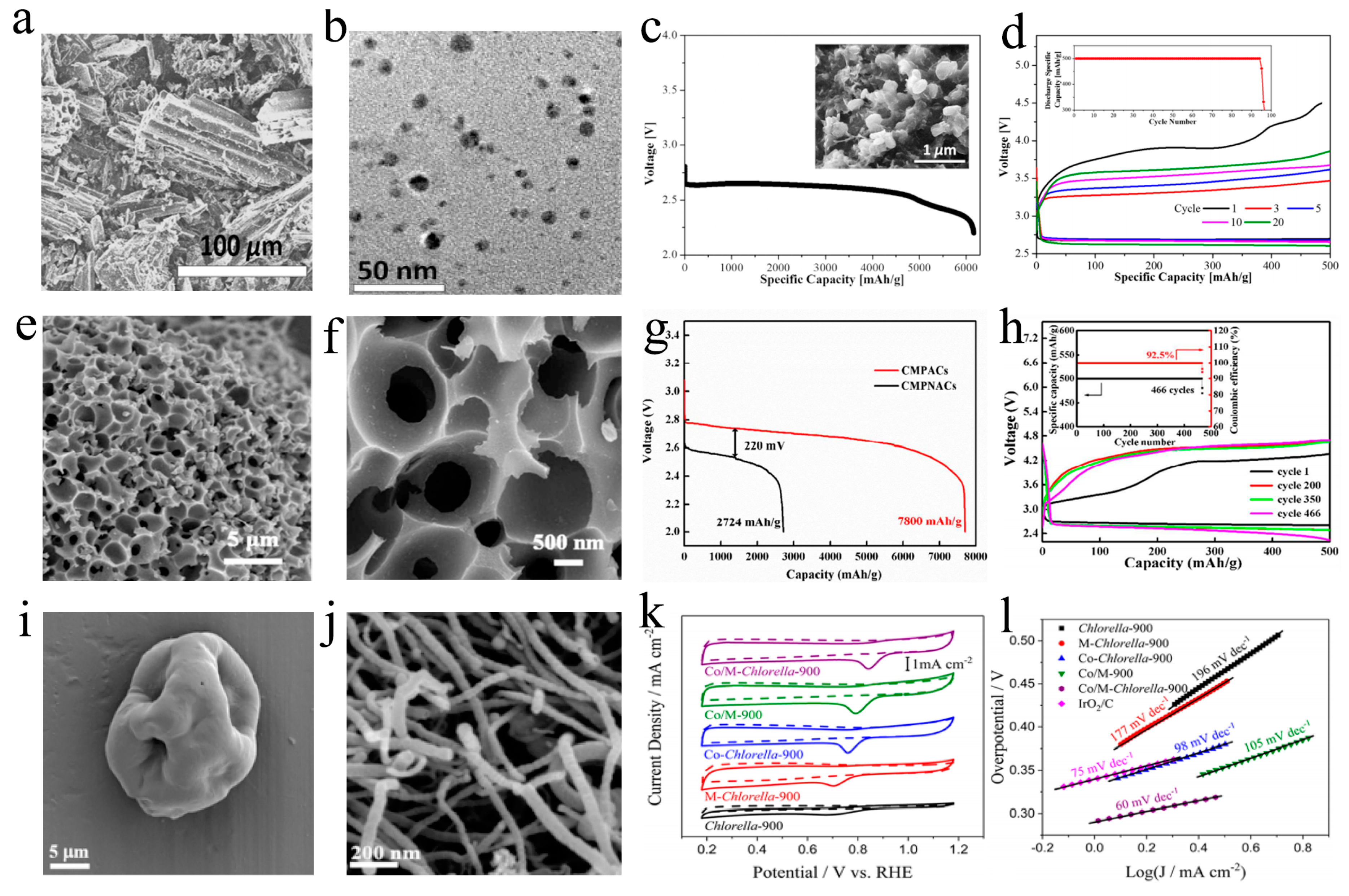
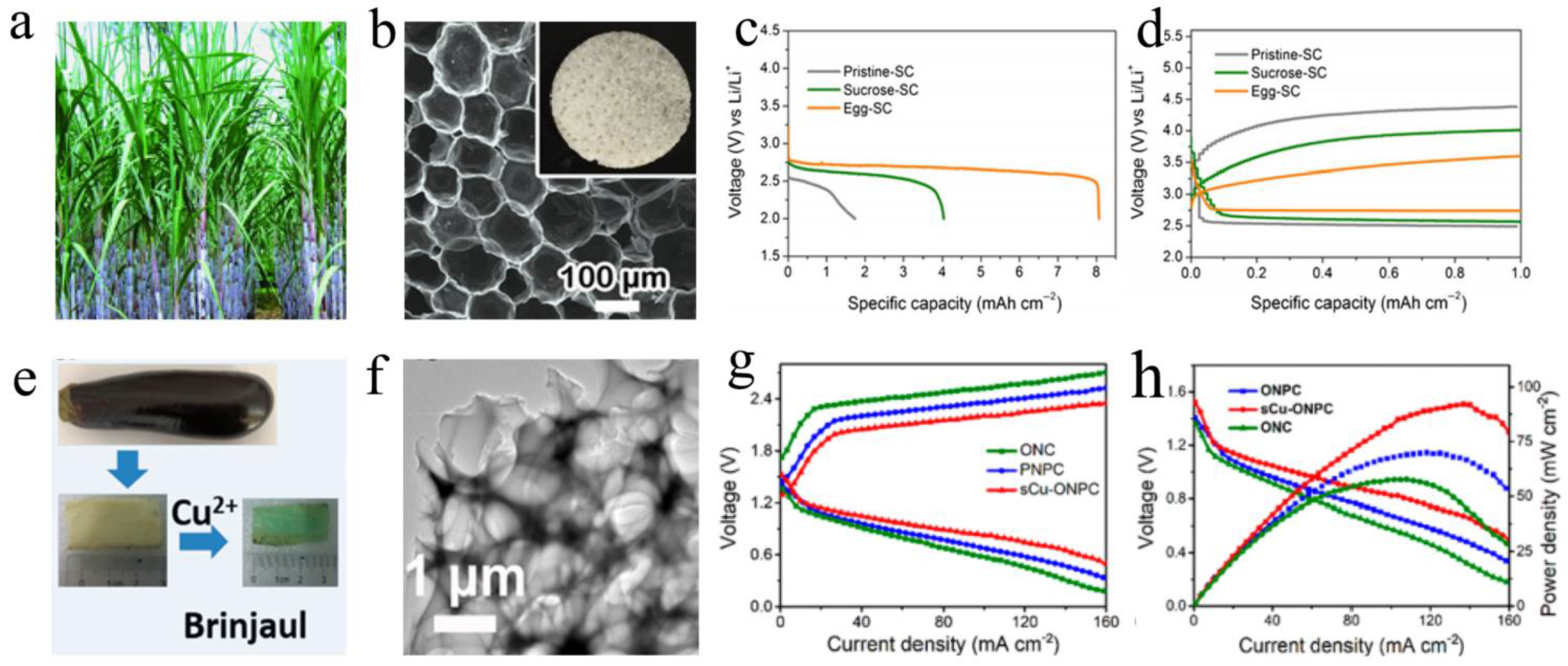
| Biomass | Heteroatoms | ORR/OER Eonset or Half-Wave Potential (E1/2) (V) | Tafel Slope (mV dec−1) | Energy Storage Device | Ref. |
|---|---|---|---|---|---|
| Glossy privet | N | 0.92/1.01 | Zn–air | [87] | |
| Coptis | N | 1.06/1.68 | 93 | Zn–air | [90] |
| Pinecone | P | 2.7/3.2 | Li–air | [92] | |
| Peanut shell | B, N | 0.95 | 59.0 | Zn–air | [93] |
| Spirulina | N | 0.96 | 69.7 | Zn–air | [94] |
| Corn stalk | N | E1/2: 0.85 V | 108.0 | Zn–air | [95] |
| Silk fiber | N | 0.95/1.9 | 68.0 | Zn–air | [96] |
| Banana peel | N | 0.88/1.56 | Zn–air | [97] | |
| Garlic stems | N, S | 0.97/1.1 | Zn–air | [81] | |
| Bamboo | N, S | E1/2: 0.81 V | Zn–air | [82] | |
| Water hyacinth | N | 0.95 | 71.1 | Zn–air | [98] |
| Biomass | SBET (m2 g−1) | Synthesis Method | Energy Storage Device | Specific Capacity/Power Density | Ref. |
|---|---|---|---|---|---|
| Egg-sugarcane | 166 | Infiltration–carbonization | Li–air | 8.07 mAh cm−2 | [44] |
| Silkworm cocoons | 1333 | Activation–carbonization | Li–air | 1480 mAh g−1 | [121] |
| Pomelo peel | 211 | Impregnation–carbonization | Li–air | 14 mAh cm−2 | [39] |
| Brinjaul | Auxiliary pyrolysis | Zn–air | 88.5 mW cm−2 | [122] | |
| Cotton | Activation–carbonization | Li–air | 16.9 mAh cm−2 | [123] | |
| Wood | Vapor deposition-carbonization | Li–air | 9.44 mAh cm−2 | [124] | |
| Poplar wood | 989 | Impregnation–carbonization | Li–air | 8.38 mA h cm−2 | [40] |
Disclaimer/Publisher’s Note: The statements, opinions and data contained in all publications are solely those of the individual author(s) and contributor(s) and not of MDPI and/or the editor(s). MDPI and/or the editor(s) disclaim responsibility for any injury to people or property resulting from any ideas, methods, instructions or products referred to in the content. |
© 2023 by the authors. Licensee MDPI, Basel, Switzerland. This article is an open access article distributed under the terms and conditions of the Creative Commons Attribution (CC BY) license (https://creativecommons.org/licenses/by/4.0/).
Share and Cite
Lv, X.; Chen, M.; Kimura, H.; Du, W.; Yang, X. Biomass-Derived Carbon Materials for the Electrode of Metal–Air Batteries. Int. J. Mol. Sci. 2023, 24, 3713. https://doi.org/10.3390/ijms24043713
Lv X, Chen M, Kimura H, Du W, Yang X. Biomass-Derived Carbon Materials for the Electrode of Metal–Air Batteries. International Journal of Molecular Sciences. 2023; 24(4):3713. https://doi.org/10.3390/ijms24043713
Chicago/Turabian StyleLv, Xiaodong, Ming Chen, Hideo Kimura, Wei Du, and Xiaoyang Yang. 2023. "Biomass-Derived Carbon Materials for the Electrode of Metal–Air Batteries" International Journal of Molecular Sciences 24, no. 4: 3713. https://doi.org/10.3390/ijms24043713
APA StyleLv, X., Chen, M., Kimura, H., Du, W., & Yang, X. (2023). Biomass-Derived Carbon Materials for the Electrode of Metal–Air Batteries. International Journal of Molecular Sciences, 24(4), 3713. https://doi.org/10.3390/ijms24043713





